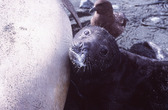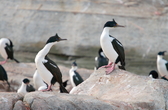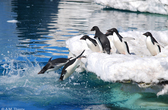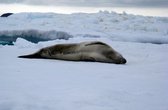219 species founded
-
 13116
13116
Orcinus orca
Common name - Orca (Killer) Whale
Killer whales are among the oceans’ most iconic species. Their large size, striking appearance, complex social structure and top predator status give them great charisma. They are the apex predators in marine ecosystems and, as a species, have an incredibly varied diet. Considered among the most widely distributed non-human mammals on the planet, killer whales occur throughout the world’s oceans. Killer whales (or orcas) are toothed whales (o...View more
-
 12215
12215
Hydrurga leptonyx
Common name - Leopard Seal
Long, slim body, with disproportionately large head separated from body by marked constriction at neck. They have a characteristic 'reptilian' appearance to their head; a wide gape of jaws and characteristically three-pronged teeth, which makes identification easy. The teeth of the leopard seal have a dual role; the large re-curved canines and incisors are designed for gripping and tearing prey, whereas the upper and lower tricuspid (three ...View more
-
 11964
11964Pygoscelis antarcticus
Common name - Chinstrap Penguin
First described by Johan Reinhold Forster (1781), chinstrap penguins are an ice-intolerant species. They are one of the most easily recognisable penguin species, named for a distinctive, thin band of black feathers that runs across their chin, appearing as a chinstrap connecting black feathers across the crown of their skull and back against an otherwise white body. The penguin phylogenetic tree finds pygoscelid (“brush-tailed”) species...View more
-
 11721
11721Pygoscelis adeliae
Common name - Adélie Penguin
Adélie penguin is one of the most common penguin species along the Antarctic coast, and it is probably also the most studied species. They are obligate inhabitants of the pack ice that surrounds the Antarctic continent. They breed from late October to early March in colonies that are found on ice-free coastal areas. During this time, they alternate between foraging trips at sea and sojourns on land to incubate the egg or rear their two chicks. ...View more
-
 11511
11511Lobodon carcinophaga
Common name - Crabeater Seal
Crabeater seals have a circumpolar distribution, and are largely restricted to Antarctic pack-ice which makes them difficult to access for scientific study. Adults are 2.0-2.6 m in length, with females slightly larger than males. Weight can vary considerably throughout the year, but are typically in the range of 180-225 kg. Colour is also variable with old, pre-moult coats being silvery white and post-moult coats light to medium brown. T...View more
-
 10671
10671
Mirounga leonina
Common name - Southern Elephant seal
Southern elephant seals are phocids, or true seals, and are the largest of all seal species. They have a circumpolar distribution, breeding mainly on subantarctic islands. At sea they have been found to inhabit almost all of the Southern Ocean and travel long distances during their foraging migrations. They are highly sexually dimorphic, with males (over 4000 kg) being up to ten times larger than females (~450 kg). Males will attempt to joi...View more
-
 10587
10587
Phalacrocorax atriceps
Common name - Cormorant (Blue-Eyed Shag)
The Blue-eyed Shag, or Cormorant, is found on the western side of the Antarctic Peninsula, the Scotia Arc, South Georgia and the western coast of South America. They are the only member of the Cormorants to venture down into the Antarctic proper, with colonies found as far as 68 degrees south. They are unique among Antarctic and sub-antarctic birds in that they will maintain a nest year-round where the sea is open and they actively avo...View more
-
 10369
10369
Aptenodytes forsteri
Common name - Emperor penguin
Emperor penguins are the largest and heaviest member of the penguin family. Males and females look alike but their songs differ. Measured from the tip of their beaks to the tip of their tails they are approximately 1 m long but when they are upright they stand about 70 cm tall. Their necks comprising 13 vertebrae are flexible and highly extendable. When an adult pulls in its head, the cervical vertebrae form a strong S-bend and shorten ...View more



